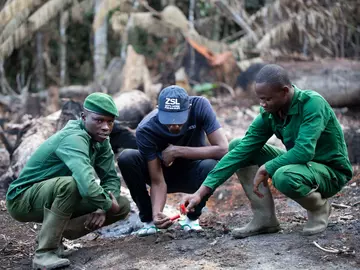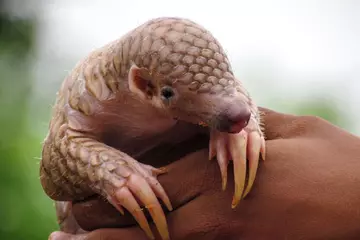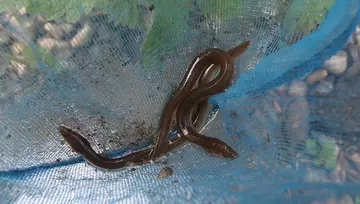
ZSL
Zoological Society of London
ZSL experts explain why the Convention on International Trade in Endangered Species of Fauna and Flora matters for threatened species across the globe.

Dr Andrew Terry, Director of Conservation and Policy at ZSL
This framework convention doesn’t get the same grandstanding attention as either climate change or biodiversity – and yet it’s incredibly important for wildlife. Indeed, it is the only one of the three that is legally-binding.
One of the leading drivers of nature loss is over-exploitation; how we as humans use the species with which we share this planet. The simple fact is, our consumption knows no bounds and continues to grow.
Humans rely on other species for a wide variety of reasons; daily protein, building materials, religious and cultural uses, medicinal and recreational. We also use species as symbols of wealth and status. Many species cannot sustain this pressure and decline, moving closer to extinction. As they become rarer, the perversions of markets can set in, driving the price up and promoting greater exploitation of fewer individuals.
At ZSL, we believe that sustainable levels of trade and use are important parts of our society. But there need to be equitable and transparent levels of offtake that enable species to persist and thrive in perpetuity. These levels must be scientifically based, monitored and enforced.
This is where CITES comes in. The Convention aims to ensure that international trade in wild animals and plants does not threaten their survival. ZSL has been engaging with the Convention for over a decade to ensure that a science and evidence-led approach underpins its implementation. We aim to improve the status of species directly impacted by trade and we have the scientific and field experience to help inform the discussions setting regulations surrounding trade.
Using knowledge and experience from decades of scientific work and conservation action we feed into technical discussions for a range of species - from eels and sharks to cheetahs and pangolins.
These then provide a basis for cross-cutting agenda items relating to the legality and sustainability of this trade. Sometimes these discussions can pass quickly in a flurry of technical jargon and sometimes they become highly emotive and political. But all are vital for the species involved.
As a science-based, zoological institution, we believe zoos and aquaria have an important role in supporting global discussions to set regulations governing trade in species. Zoos and aquaria, including London and Whipsnade, can play a key role in species recovery - from our vast experience caring for threatened species, we have detailed knowledge that can help inform regulation setting.
Our team will be at CITES COP19 in Panama, working with global partners into the early hours to review and agree regulations and policies to ensure that the trade in wildlife does not continue to drive species towards extinction.

Carly Waterman - Pangolin Technical Specialist at ZSL
Pangolins, or scaly anteaters, are widely believed to be the world’s most trafficked wild mammals.
There are eight recognised species, four in Asia and four in Africa. All are considered under threat of extinction, primarily due to poaching and illegal trade. Historically traded commercially in large numbers for their body parts, Asian pangolins have suffered from large population declines over the past century. Since 2016, all eight species have been included on the CITES list for the most endangered animals, Appendix I.
Since then, almost all legal international commercial trade in pangolins has ceased. However, large volumes of pangolins continue to be traded illegally. A single shipment can contain several tonnes of scales, equating to thousands of individual pangolins. Although little is known about the status of wild pangolin populations, this trade is likely pushing these unique animals towards extinction.
CITES COP19 will consider multiple recommendations to support pangolin conservation and crack down on illegal trade. These include the development of targeted conservation programmes, further research into the status of wild populations and the magnitude of their trade, the stepping up of law enforcement and the securing of stockpiles of seized pangolin parts.
A lot of work is required, but range states are stepping up to the challenge. With the involvement of organisations such as ZSL - who run numerous pangolin conservation projects - we remain optimistic that a future for wild pangolins can be secured.

Matt Gollock - Marine and Freshwater Programme Lead at ZSL
Anguillid eels are harvested and traded at several life stages, primarily for farming and/or consumption. At CITES COP14 in 2007, the Critically Endangered European eel was listed in Appendix II of the Convention, allowing international trade to continue, provided there is evidence that harvest is sustainable. However, concerns in 2010 about the status of European eels led to the EU ceasing trade of the species. This decision resulted in an increase in exports of European eels and other anguillids outside of the EU, as well as growing worry surrounding illegal harvest and trade.
Since 2016, CITES Parties have agreed to examine the trade of all anguillids with the aim to better understand global interlinkages, knowledge gaps, and what can be done to tackle the situation. ZSL has delivered three reports on eel trade to CITES, highlighting several areas requiring attention, and presented a series of recommendations to address them.
At COP19, there will be an ongoing focus on ensuring that trade in the European eel is sustainable, legal and traceable, and that key knowledge gaps from both import and export countries are addressed. ZSL will be working with likeminded Parties and organisations to ensure the best available evidence informs and underpins any Decisions that are adopted and drive effective implementation of them over the coming three years.

Sarah Durant – Professor at ZSL
Despite increased law enforcement, illegal trade in cheetahs has continued. Over 400 cheetahs are estimated to have been traded illegally each year over the last decade - the majority of these are live cubs, many of whom die soon after capture.
Gulf States are the main destination countries for this illegal trade, and hence the trade has a particularly strong impact on the small and highly threatened cheetah populations in the nearby Horn of Africa, which are the main source populations for the trade.
These populations comprise of a rare and threatened subspecies, the Northeast African cheetah, and as populations in this region decline, cheetahs in other regions will become increasingly vulnerable to trade.
CITES COP19 provides an important opportunity for countries to step up actions to combat illegal trade in cheetah. Several actions have proposed to address this trade, including increasing law enforcement and stepping up action to address the online sale of cheetahs. All countries impacted by cheetah trade must work together to adopt these decisions, and collaboratively implement the actions proposed.
A full technical breakdown of ZSL’s activities at CITES COP19 can be found within ZSL’s COP19 Policy Positions and Recommendations.
The ongoing COP 27, CITES COP 19 in Panama and COP15 in Montreal in December, will together put a much-needed spotlight on the decline in global biodiversity.
But without coordinated nature-based policies in place across the world, animals will continue to go extinct, ecosystems will continue to break down and climate change will continue to change life on earth as we know it.
It is vital that governments commit to using nature-based solutions - rooted in science from ZSL and organisations like it - to tackle the combined threats of climate change, biodiversity loss and public health crises.
It is with science that those in power must start: throughout conference season, ZSL is calling for world leaders to put nature at the heart of all global decision-making to better protect ecosystems, wildlife and the communities who rely on them.
Support ZSL's global science and conservation work and find out more
Climate change and human activity have pushed our precious planet to its limit, causing the devastating loss of so many habitats and species. From lab to field, hands on and behind the scenes, we’re leading the future of conservation, shaping agendas and influencing change to support better life, health and living for people and wildlife.
